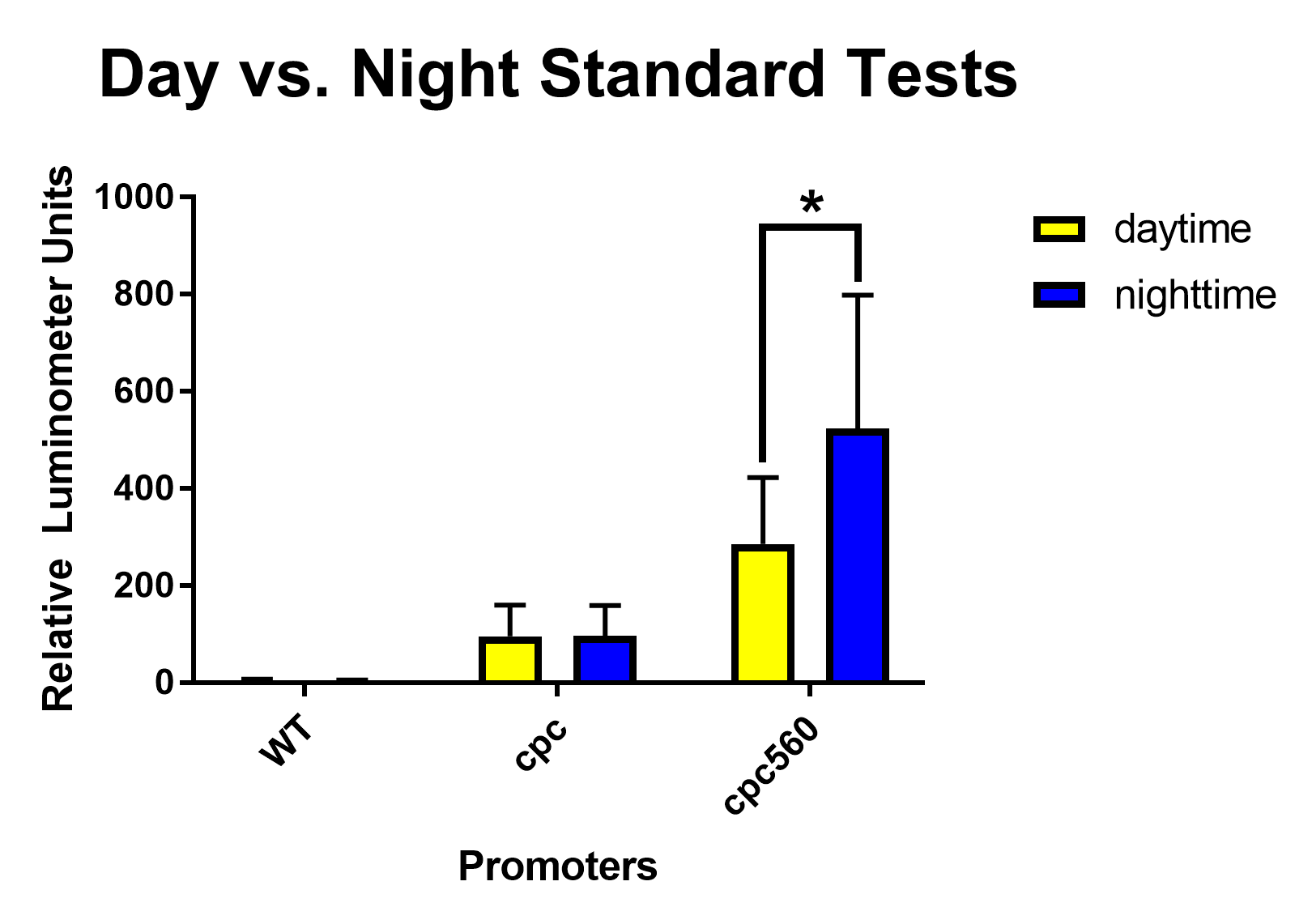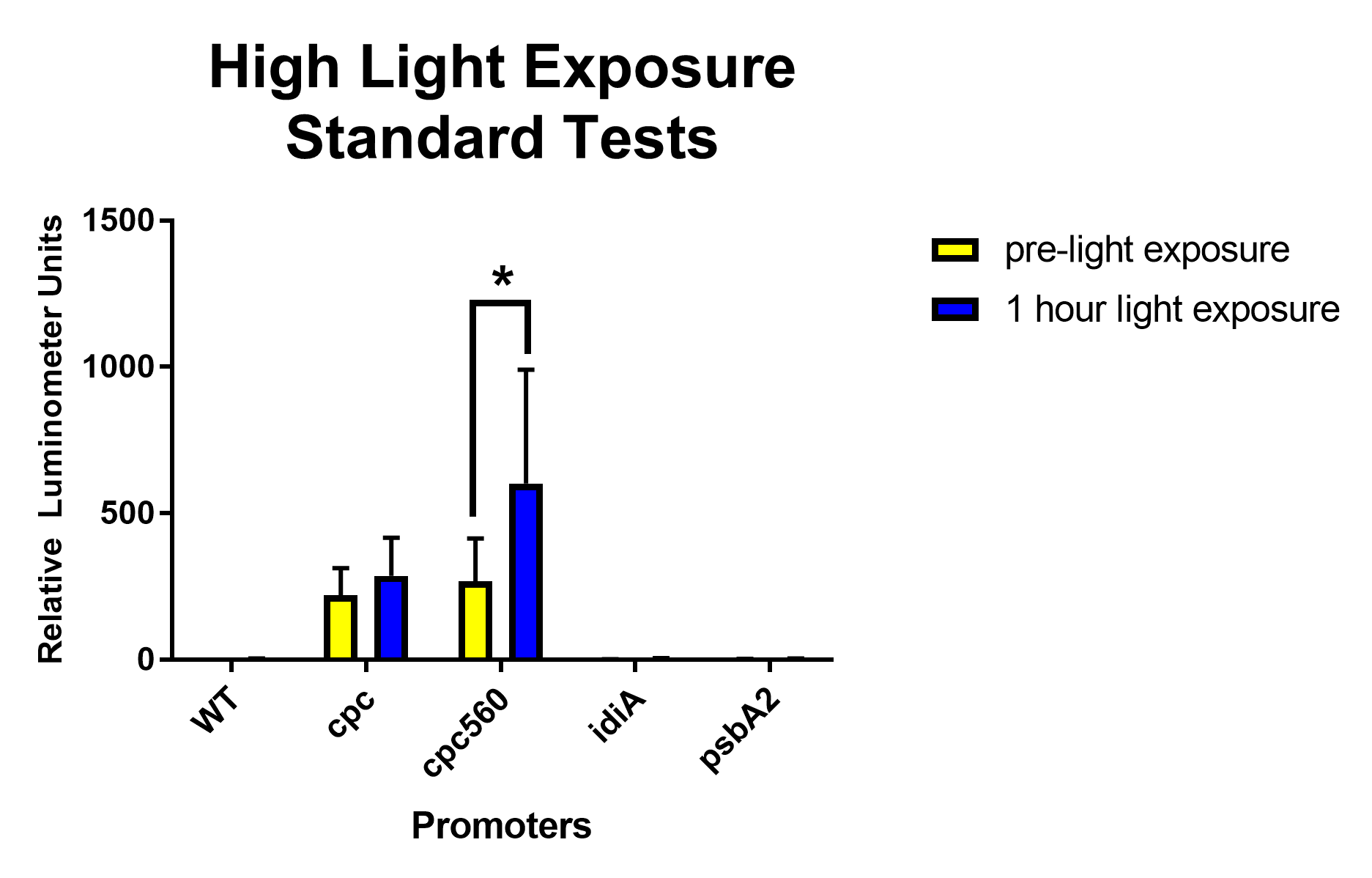Difference between revisions of "Part:BBa K2596006"
(→Luciferase Assays) |
|||
| Line 3: | Line 3: | ||
<partinfo>BBa_K2596006 short</partinfo> | <partinfo>BBa_K2596006 short</partinfo> | ||
| − | This is a strong constitutive promoter from cyanobacteria Synechocystis sp. PCC 6803 | + | This is a strong constitutive promoter from cyanobacteria <em>Synechocystis sp.</em> PCC 6803 |
<!-- Add more about the biology of this part here --> | <!-- Add more about the biology of this part here --> | ||
===Usage and Biology=== | ===Usage and Biology=== | ||
| − | Pcpc-560 is a unique form of the Pcpc promoter native to Synechocystis sp. 6803. It includes the two cpc promoters (as described for Pcpc) and 14 | + | <em>Pcpc-560</em> is a unique form of the <em>Pcpc</em> promoter native to <em>Synechocystis sp.</em> 6803. It includes the two <em>cpc</em> promoters (as described for <em>Pcpc</em>) and 14 transcription factor binding sites, allowing it to be an incredibly strong promoter. |
<!-- --> | <!-- --> | ||
<span class='h3bb'>Sequence and Features</span> | <span class='h3bb'>Sequence and Features</span> | ||
<partinfo>BBa_K2596006 SequenceAndFeatures</partinfo> | <partinfo>BBa_K2596006 SequenceAndFeatures</partinfo> | ||
| − | For the BioBrick, we kept the full 560 bp of Pcpc-560, and did not include an upstream region. The full cpc-560 promoter ends immediately before the ATG start codon in its native form. | + | For the BioBrick, we kept the full 560 bp of <em>Pcpc-560</em>, and did not include an upstream region. The full <em>cpc-560</em> promoter ends immediately before the ATG start codon in its native form. |
<!-- Uncomment this to enable Functional Parameter display | <!-- Uncomment this to enable Functional Parameter display | ||
Revision as of 08:55, 17 October 2018
Pcpc560 from Synechocystis sp. PCC 6803
This is a strong constitutive promoter from cyanobacteria Synechocystis sp. PCC 6803
Usage and Biology
Pcpc-560 is a unique form of the Pcpc promoter native to Synechocystis sp. 6803. It includes the two cpc promoters (as described for Pcpc) and 14 transcription factor binding sites, allowing it to be an incredibly strong promoter. Sequence and Features
- 10COMPATIBLE WITH RFC[10]
- 12COMPATIBLE WITH RFC[12]
- 21COMPATIBLE WITH RFC[21]
- 23COMPATIBLE WITH RFC[23]
- 25COMPATIBLE WITH RFC[25]
- 1000COMPATIBLE WITH RFC[1000]
For the BioBrick, we kept the full 560 bp of Pcpc-560, and did not include an upstream region. The full cpc-560 promoter ends immediately before the ATG start codon in its native form.
Luciferase Assays
Experimental Methods:
In order to test the expression of our promoters, cpc (BBa_K2596001), cpc560 (BBa_K2596006), idiA (BBa_K2596004), psbA2 (BBa_K2596003), which were incorporated into Dr. Susan Golden’s vector pAM1414 using Gibson assembly, we conducted luciferase experiments. Following Dr. Golden’s procedure, we added 5 µL of decanal to 95 µL of cyanobacteria in each well to induce expression. The decanal acted as a substrate for the bacterial luciferase enzyme, but due to the toxicity, the cells ended up dying, so the data obtained represents the end static expression. For the standard expression experiments for nighttime and daytime, we plated 95 µL of cyanobacteria into a 96 well plate, added 5 µL of decanal, parafilmed the edges and left the plate for 15 minutes before measuring the luminescence in a plate reader. For the psbA2 experiment, we plated 95 µL of cyanobacteria to half of the wells and put them under at least 500 µE of high light in our incubator for 1 hour. Then, we added 95 µL of cyanobacteria not exposed to high light to the other half of the wells and added 5 µL of decanal to all of the wells. Then, we placed the well plate in a plate reader and measured the luminescence.
Results:
After removing outliers from the data set using the 1.5(IQR) rule and conducting unpaired T-tests assuming unequal variance, both cpc and cpc-560 showed significant differences for daytime expression compared to wild type [Figure 1]. Compared to cpc, cpc-560 had a significantly higher expression [Figure 1]. In comparison for day compared to night, cpc did not show any significant difference [Figure 2]. On the other hand, cpc-560 showed a significant difference between daytime and nighttime expression [Figure 2].
After removing outliers from the data set using the 1.5(IQR) rule and conducting unpaired T-tests assuming unequal variance, for daytime expression, compared to all other promoters and the wild type, cpc and cpc-560 had significant differences in expression [Figure 1]. For idiA and psbA2, they only had significant differences compared to cpc and cpc-560, and not to each other [Figure 1]. When exposed to highlight, idiA and psbA2 did not show any expression [Figure 3].



